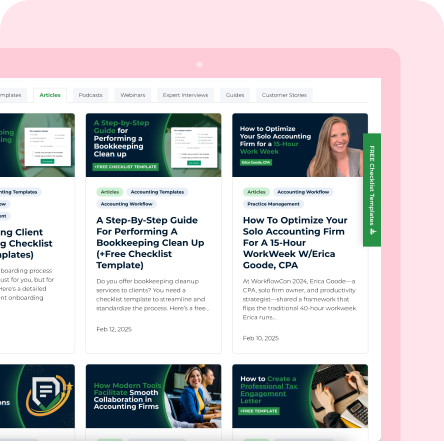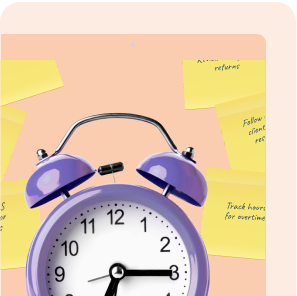You walk into an office where desks are buried under stacks of paper.
Employees scramble to find documents, deadlines are missed, and clients are left wondering why their requests take weeks instead of days. Now, imagine the opposite—a firm where every team member knows exactly where to find information, who is responsible for what, and what stage a project is in at any given moment.
This is the difference between a firm that lacks workflow transparency and one that has mastered it. At WorkflowCon 2024, Deborah Defer, director of CAS Consulting at Woodard, didn’t just talk about workflow transparency, she gave a battle-tested roadmap to achieving it.
With decades of experience helping firms move from chaos to clarity, Defer broke down the barriers to transparency, identified the most common workflow pitfalls, and shared the exact steps firms need to take to build a seamless, high-performing system. This is not just another business theory. It is a practical, deeply analytical guide that will help any firm bridge the gap for workflow transparency step by step.
The Three Major Pitfalls That Destroy Workflow Transparency
Before fixing a problem, you must understand what is breaking it. Defer identified three fundamental failures that create gaps in workflow transparency.
1. Miscommunication and Information Silos
When employees do not have access to the right information, they make mistakes. Deadlines slip, and work gets duplicated. Critical tasks fall through the cracks without a centralized system for tracking projects.
Without clear, concise steps, there’s confusion. We don’t know who’s responsible for what. People get frustrated, then you get low employee morale. And then we lose the client."
This is not just a logistical issue, it is a business risk. If employees cannot see the full picture of a project, they cannot execute their roles efficiently.
2. Lack of Standardized Workflows
Every firm has processes. But if those processes are not standardized, every employee will do things their way, leading to inconsistencies, errors, and inefficiencies.
We know the biggest enemy of processes is the lack of standardization. It’s a horrible enemy, and it affects the quality of work."
A well-documented workflow ensures that every employee follows the same steps, delivering consistent results to clients.
3. Accountability Gaps
If no one is responsible for tracking workflow progress, deadlines get missed, and tasks remain incomplete. Accountability must be built into the system itself.
We want to make sure that we designate department leads over the implementation and oversight. Subject Matter Experts (SMEs) should raise their hands and ensure that everybody is clear on their roles."
A transparent workflow assigns clear owners to each step, ensuring that projects move forward without delays.
The Power of the Three P’s: Policies, Processes, and Procedures
If you want to create a transparent and efficient accounting workflow, you need structure. Without it, tasks get lost, deadlines are missed, and employees waste time figuring out how to complete their work. Speaking at WorkflowCon 2024, Deborah explained that the key to a well-functioning system is following the Three P’s: policies, processes, and procedures.
She said, “I like to talk a lot about the three P’s: policies, processes, and procedures. If we can follow these, we can avoid many pain points.”
Think of the Three P’s as the foundation of a well-structured workflow. They ensure that everyone in your organization understands how work should be done, who is responsible for what, and what steps need to be followed. When implemented correctly, they reduce confusion, improve accountability, and create an efficient workflow.
Policies: The Rules That Keep Everything in Check
Policies are the guidelines that define how work should be done in your firm. They set the expectations and establish a standard for everyone to follow. Without clear policies, employees make decisions based on their judgment, which leads to inconsistency, errors, and inefficiencies.
Imagine a firm where every team member handles client onboarding differently. One person might request documents immediately, while another waits until the client reaches out. One might schedule an introduction call, while another will prepare reports. Without a policy, the client experience becomes unpredictable, and employees struggle to maintain consistency.
Your policies should answer these questions
- What are the expectations for completing specific tasks
- What tools and software must employees use for different projects
- What compliance and security standards must be followed
- How should communication and approvals be handled
Policies ensure that everyone operates under the same rules. They provide a sense of stability and clarify what is expected from each team member. Without them, your firm will struggle with inconsistency and inefficiency.
Processes: The Framework That Keeps Work Moving
A process is a structured sequence of steps that helps you complete tasks efficiently and repeatably. It provides a roadmap for your team, guiding them from the beginning of a task to its completion.
Deborah highlighted the importance of standardizing processes. She said, “We know the biggest enemy of processes is the lack of standardization. It’s a horrible enemy, and it affects the quality of work.”
When processes are inconsistent or undocumented, employees spend unnecessary time trying to figure out what to do. Mistakes increase, deadlines get missed, and efficiency suffers.
A well-defined process should clarify
- The exact steps required to complete a task
- Who is responsible for each step
- When approvals or checkpoints are needed
- What happens if a task is delayed or incomplete
Deborah Defer shared a real-life example of what happens when firms lack clear processes. “I asked a firm, ‘If I put a new employee in your department tomorrow, how long would it take them to figure out your process?’ The response was, ‘They would have to ask me everything.’ That’s a problem.”
Your processes should be structured in a way that allows a new hire to follow them without needing constant guidance. When processes are well-documented, work becomes predictable and efficient.
Procedures: The Step-by-Step Guide for Every Task
A procedure is a detailed breakdown of how to perform a specific task. While a process tells you what needs to be done, a procedure explains exactly how to do it.
Think of a procedure as a recipe. It does not just tell you to bake a cake; it also tells you the exact ingredients, measurements, oven temperature, and baking time. Without those details, you would end up with a mess instead of a cake.
Your procedures should include
- A step-by-step guide for completing tasks
- A checklist of required tools or resources
- Guidelines for handling exceptions or unexpected situations
- Templates or examples to maintain consistency
When we have procedures, these are really what it is that we’re supposed to be getting done. And in order to complete those things, we have to have activities or tasks underneath them.""
If your firm lacks clear procedures, employees will complete tasks differently every time, leading to errors, delays, and frustration. Having a set of documented procedures ensures that every team member follows the same approach, producing consistent results.
The Step-by-Step Guide to Bridging the Gap for Workflow Transparency
If you want to build a workflow that is transparent, efficient, and easy to manage, you need a structured approach. A clear workflow allows everyone on your team to see where tasks are, who is responsible for them, and what needs to happen next. Without transparency, work falls through the cracks, deadlines are missed, and confusion spreads throughout your firm.
If I put a new employee in your department tomorrow, how long would it take them to figure out your process? If the answer is that they would have to ask you everything, that is a problem."
This step-by-step guide will help you transform your workflow into a clear and structured system that reduces confusion and improves accountability.
Step One: Conduct a Full Workflow Audit
Before making any changes, take a step back and examine your workflow’s current operations. You cannot fix a problem if you do not know where it exists.
Start by mapping out every stage of your workflow. Look at how tasks move from one person to another. Identify where delays happen. Find out if certain tasks get stuck with the same people. Pay attention to how your team communicates about ongoing projects.
You should also ask yourself these questions:
- Do employees have access to the information they need to complete tasks
- Are there frequent bottlenecks that slow down projects
- Is there a clear process for tracking the status of each task
- Do employees spend too much time looking for documents or waiting for approvals
- Are deadlines being missed due to miscommunication or lack of accountability
It made me sick to my stomach. I told her, we gotta help you. We have to make sure it’s not just stuck on somebody’s desk because things get lost."
Your audit should expose these kinds of inefficiencies. Once you understand what is broken, you can start fixing it.
Step Two: Implement Technology That Improves Visibility
Once you know where the gaps are, you need the right tools to close them.
A transparent workflow requires a system where everyone can easily see the progress of a task without having to send emails or make phone calls.
Cloud-based workflow management tools help your team track projects in real-time. These tools allow employees to update task statuses, upload documents, and communicate without relying on outdated spreadsheets or paper files.
Deborah stressed the importance of leveraging technology to create transparency.
Transitioning and moving to the cloud has made it way more transparent and efficient for us to find out where the data is, what status it’s in, and who we’re waiting on."
If you want to improve workflow transparency, you should consider Financial Cents, a workflow management software that:
- Provides a centralized dashboard where employees can see project progress
- Allows your team members to leave notes, updates, and comments on tasks
- Automates task reminders and deadline notifications
- Integrates with communication tools like email and messaging platforms
By making workflow information accessible to everyone, you eliminate confusion and reduce the time spent chasing down updates.
Step Three: Clearly Define Roles and Responsibilities
A transparent workflow only works when everyone knows exactly what they are responsible for. If tasks are assigned vaguely or if multiple people think they are in charge of the same thing, work will get delayed.
You need to ensure that there is a clear owner for each stage of the workflow for every project. Define who is responsible for starting a task, completing it, reviewing it, and approving it. If multiple departments are involved, make sure handoffs between teams are documented.
Deborah explained, “We want to make sure that we designate department leads over the implementation and oversight. Subject Matter Experts should raise their hands and ensure that everybody is clear on their roles.”
Ask yourself these questions when assigning roles:
- Does every team member know exactly what their responsibilities are
- Who is in charge of reviewing and approving work before it moves forward
- Who should employees go to if they have questions about a task
- Is there a process for handing off work from one team to another
- Are there clear expectations for when tasks should be completed
If employees are unsure of their responsibilities, their workflow will become disorganized. Clear role assignments eliminate that confusion and keep projects moving forward.
Step Four: Establish a Centralized Communication System
One of the biggest obstacles to workflow transparency is scattered communication. If project details are buried in email threads, text messages, or informal conversations, your team will struggle to stay aligned.
You need a centralized communication system where employees can see all discussions related to a specific project. This ensures that important information is not lost and team members can quickly find the context they need to complete their work.
If somebody’s out of the office, you want to be able to go in and look at the string of emails within that client engagement. If Outlook is connected to the workflow, it’s a game-changer."
To improve workflow transparency, you should
- Use project management tools that allow comments and updates on tasks
- Connect email systems to your workflow platform so messages are easily accessible
- Make sure all client-related communication is stored in one place
- Train employees to document important discussions in a shared system
Employees who can easily access past conversations and project notes make better decisions and avoid miscommunication.
Step Five: Pilot the New Workflow Before Full Implementation
Once you have redesigned your workflow, do not rush to roll it out to your entire firm. Test it with a small group first. A pilot program allows you to identify any issues and make adjustments before making the new system company-wide.
Start by selecting a small number of projects or teams to use the new workflow. Monitor how well tasks move through the system. Get feedback from employees about what is working and what needs improvement. Adjust the workflow based on real-world use before applying it to the rest of your firm.
I really like to document as we go through. I love to use what I call a pilot and establish sandboxes, making sure that we’re dotting our I’s and crossing our T’s."
Your goal should be to refine the workflow until it operates smoothly before expanding it to the entire firm.
Step Six: Schedule Regular Workflow Reviews and Adjustments
Workflows are not something you create once and never revisit. Your business will change over time. New challenges will arise, and better tools will become available. You need to regularly review and refine your workflow to keep it effective.
Schedule periodic meetings to assess how well your workflow is functioning. Look at key performance indicators like project completion rates, missed deadlines, and employee feedback. If problems arise, update your workflow to fix them.
The only thing that’s constant in life is change, so we have to make sure that we have regular reviews and that we’re updating that information."
A transparent workflow is always evolving. If you stay committed to continuous improvement, your firm will operate more efficiently over time.
A Transparent Workflow is the Key to Long-Term Success
The firms that succeed are the ones that take control of their processes. They document their workflows, define their roles, and use technology to create visibility across teams.
They understand that transparency is about building trust with clients, increasing profitability, and giving employees the structure they need to thrive.
Now is the time to evaluate your firm’s workflow. Look at where tasks are getting stuck. Identify where miscommunication is slowing you down. Start making small changes that lead to big improvements. The more transparent your workflow becomes, the more control you will have over your success.






